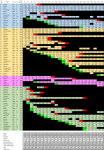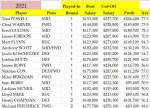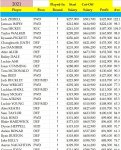Many thanks again
@Beg2Differ. The new run-thru looking for an optimum G&R starting line-up is very interesting and like
@Darkie, I will be thinking about it for a while.
So now we can see that the best G&R line-up would yield a season-score in the region of 62,000 as compared with the optimum of 62,839. This is definitely a much smaller gap than I was expecting, so my championing of a value/mid-pricer strategy is diminished – if not entirely extinguished. My expectation (and hope) was a difference of 3,000 - 4,000.
I was convinced that the “value” starting picks in optimal team were the key to generating the cash that enabled the swag of big guns that the model subsequently traded in across the 2021 season. It now clear that most of this was equally achievable with a G&R structure – so it may be that the optimiser cannot really be used to argue my case.
The new G&R run suggests that good trading is more decisive than a good starting line-up. For me, it’s back to being a more open question – whether G&R is the better way to go – or not. Things to mull over a bit further..
- The way I see it is that a good value line-up is “buying” more points with my $10M – this can’t be a bad thing – but may be hard to achieve – is it worth persisting?
- The flow of rookies thru the season always seems to be important – but doesn’t feature in either optimising solution.. interesting..
- The optimal value solution “beats” the optimal G&R solution by about 800 pts – at first it doesn’t seem like much but perhaps it is worth holding on to.
Thanks again for going the extra mile – the new information definitely adds a lot to my shaky understanding of SC.




